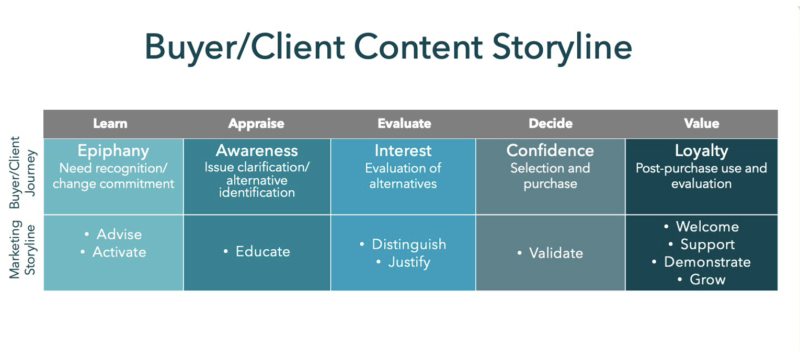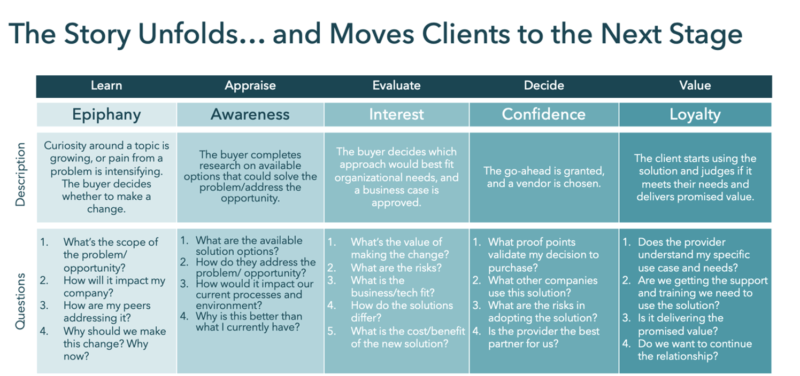Accelerating client-led growth through client-centric storylines
In the current competitive environment, client centricity has become more crucial than ever. However, many organizations still struggle to implement it effectively, which has a significant impact on their bottom line. A client-centric content engine can be a crucial component in overcoming these challenges to drive sustainable growth.
A long-standing yet underutilized approach
Client centricity is not a novel concept. Many B2B organizations claim to place clients at the core of their business strategy, aiming to deliver innovative solutions tailored to meet the unique needs of their customers. A glance at the marketing materials of almost any B2B company supports this case.
However, the reality of client centricity often falls short. According to Value of Thought Leadership 2025, B2B buyers tend to have a less favourable view of their suppliers. In fact, 58% of B2B buyers state that they can’t differentiate one provider’s thought leadership from another’s. And it’s not just thought leadership. B2B marketing content tends to suffer from a similar pattern of ‘sameness’. B2B marketing content is overwhelmingly focused on what a company wants to say to its clients, rather than focusing on what clients want to know. This strategic error, combined with the fact that most B2B content is created in internal silos without a clear view of client needs, leads to significant content waste. Many of our clients suggest that only 50% of the content they create is ever used. This misalignment comes at a high cost. As of 2025, global B2B businesses collectively spend approximately $20 billion annually on content marketing; if 50% of this investment is wasted, that is a $10 billion global marketing problem.
To achieve genuine client centricity, we need to reframe some fundamental marketing questions, shifting the narrative from how to achieve our goals to how to create value for our clients and ourselves. In this way, the question of “How do we position our services?” becomes “How do we align to market needs?” “How do we want to sell to clients?” becomes “How do clients want to buy from us?” And, perhaps most critically in the content world, “What do we want to say?” becomes “What do clients want to know?”
Putting ourselves in the client’s shoes
Every B2B organization has a funnel model it uses internally to track the acquisition of buyers to clients. Some use the stages of awareness, consideration, conversion, and loyalty. Others use variations of these stages. The crucial thing to note is that all these funnel stages are from the organization’s perspective. Is the buyer aware of my company? Are they considering our solution for their purchase? And so on.
However, no prospective client is likely to say, “I’m deep in the consideration stage with Company X.” Of course not. It is not their perspective. What they are focused on is a problem they are trying to solve for their business. Or a business or technical opportunity that they are trying to capitalize on. B2B marketers need to put themselves in the client’s shoes to communicate effectively with them and cut through the market's noise.
Building client-centric storylines
Developing client-centric content requires a thorough examination of the buyer’s journey. To help clients with this, Momentum ITSMA has developed a framework that integrates the buyer’s journey with a client-centric set of content storylines. The journey covers five stages: Learn, Appraise, Evaluate, Decide, and Value.

Understanding these stages is essential for creating content that guides clients through their decision-making process, ensuring that every piece of content is tailored to meet client expectations.
Clients have specific questions that need to be answered at each stage. For example, during the ‘learn’ stage, clients’ curiosity around a topic is growing, or pain from a problem is intensifying. They will want to assess the scope of the opportunity or challenge, its potential impact on their business, how their peers are addressing the problem, and critically, why they need to address it now. By answering these questions, B2B organizations can create content that is relevant to their clients, and which also builds trust and facilitates decision-making.

A final thought
As B2B organizations shift towards a more client-centric approach, they must reassess their current content strategies. Do they have a client-centric content strategy? What does the content roadmap look like? Is the client journey fully mapped? Have sales and marketing teams come together to utilize it to its fullest potential?
These are critical questions that organizations must address to ensure they are truly meeting client needs and driving growth. Embrace them and you can build stronger relationships with clients, enhance engagement, and ultimately achieve better business outcomes. Ignore them at your peril.
Interested in learning more about creating client-centric storylines for your organization? And how both sales and marketing can apply them? Email me marcia.trask@momentumitsma.com and I can walk you through this approach in greater detail.
More in
-
The great B2B marketing reset: Why your team’s skills will define your success and growth trajectory
We read about it and we hear it all the time in our conversations with our clients: B2B marketing is under pressure like never before.
-
How future-ready B2B marketing teams win: Insights from the front lines of enablement
As an L&D Director working with top global B2B marketing teams, Jo Connolly reveals why enablement is the new growth engine – and how you can close the skills gap. Discover key findings and join our webinars for actionable strategies.
-
Transforming thought leadership into a client growth lever | Forbes
Thought leadership has transformed from a brand-building exercise into a pivotal element of enterprise decision making. It’s not just about generating interest; it's about securing trust, driving differentiation, and actively influencing purchase decisions.
